A tradition of faux bois, or trabajo rustico, in San Antonio
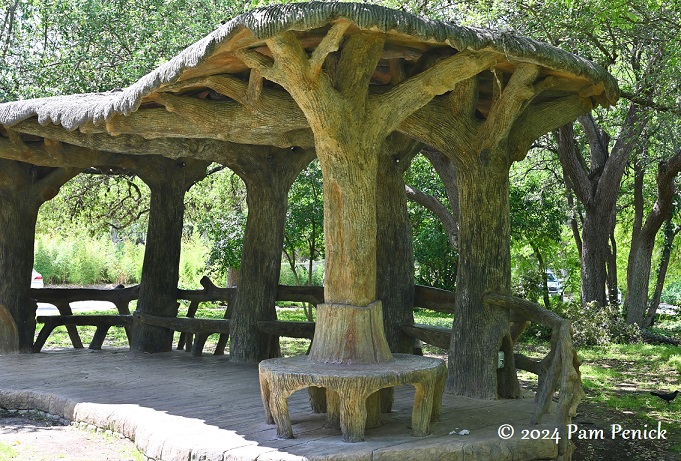
Last week I roadtripped to San Antonio to explore the city’s faux bois tradition, or trabajo rústico as it’s known locally. These functional works of art — mostly garden furniture but also planters, shade structures, bridges, and even bus stops — are made of concrete reinforced with steel and handcrafted to resemble living trees, branches, or sawn wood. They so convincingly mimic the texture, growth habit, and imperfections of real wood that they often fool the eye. A closer look and a touch turns uncertainty into delight. What magic, this manmade petrified wood!
Works of faux bois (French for “false wood”) / trabajo rústico (Spanish for “rustic work”) became a defining feature of San Antonio’s gardens and streetscapes via a circuitous route. According to Artisans of Trabajo Rústico by Patsy Pittman Light, faux bois arose in France in the mid-1800s thanks to the development of portland cement and inexpensive steel, enabling craftsmen to imitate rustic wooden structures, railings, and other park elements for picturesque effect. Faux bois spread throughout Europe and then to South America in the late 1800s via immigrants to Brazil and Argentina. From there, craftsmen took it north to Mexico and then Texas.
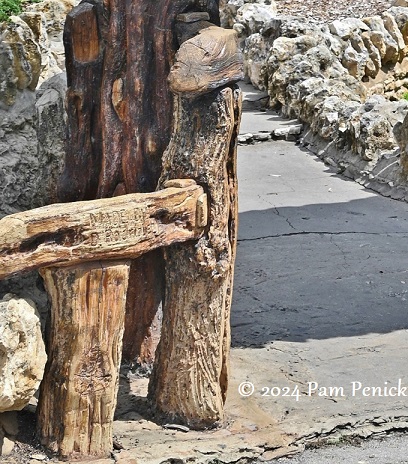
Dionicio Rodriguez brought trabajo rústico from Mexico to San Antonio in the mid-1920s. A century later, many of his works remain throughout the city, thanks in part to preservation and restoration efforts by today’s faux bois artists. These artists are few in number but dedicated to keeping the tradition alive.
Studio Cortés
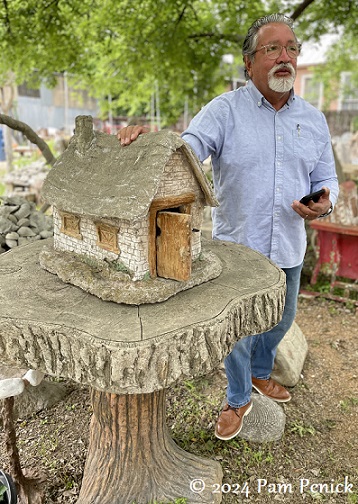
The best-known trabajo rústico artist in San Antonio today is Carlos Cortés, a 3rd-generation master of the craft. He picked it up by observing and working with his father, Maximo, when his dad was in his eighties and Carlos was in his thirties. Maximo had learned it from working with Dionicio Rodriguez.
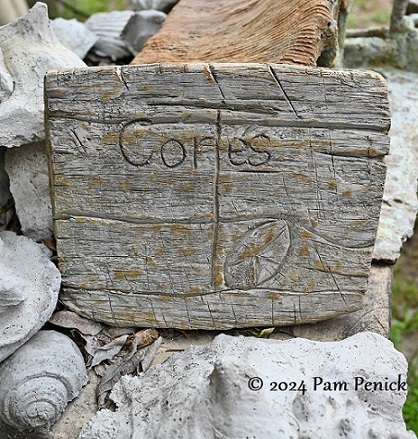
Carlos’s work is known far and wide. He has even made faux bois tables for Martha Stewart.
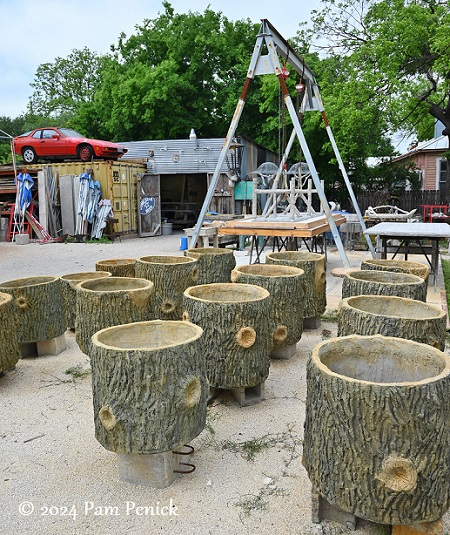
I met Carlos at Studio Cortés, his open-air workplace just south of downtown. Across the large lot, his own works-in-progress, like these tree-trunk planters, are surrounded by vintage faux bois pieces — his father’s and others’ — that he has amassed over the years. Carlos knows the history of each piece.
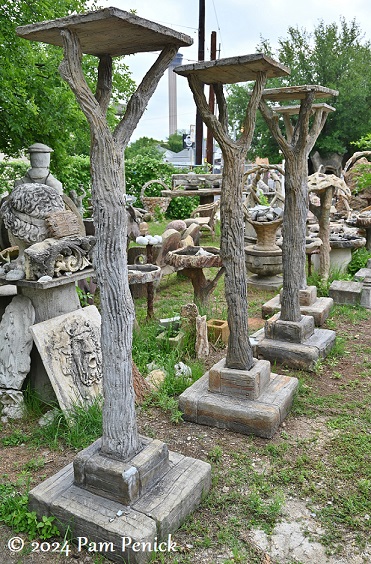
Tree trunk pedestals
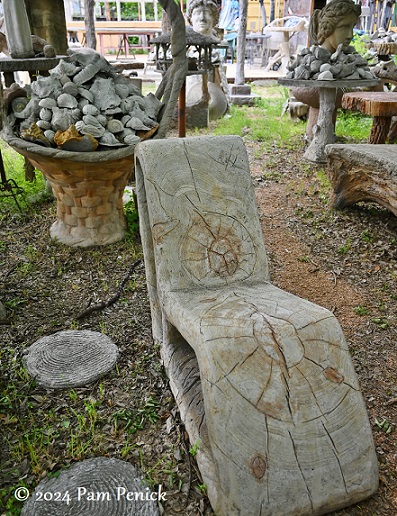
Faux bois chaise — modern style, rustic effect
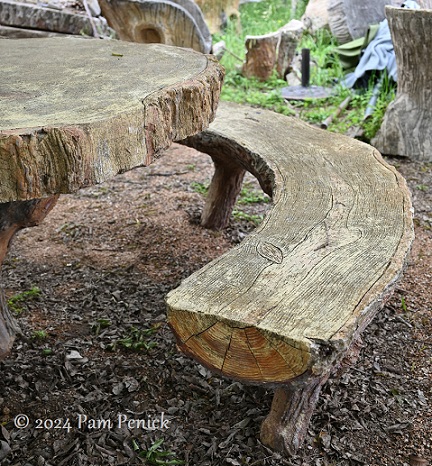
“People don’t always notice it,” says Carlos. They assume a work of trabajo rústico is real wood, not a concrete creation, and pass it by unknowingly. “And that’s good,” Carlos adds, pleased when the work convincingly fools the eye.
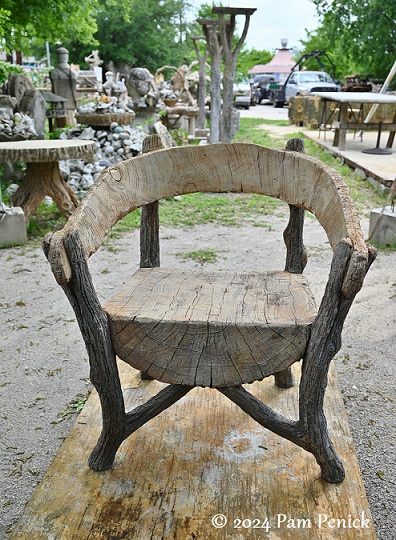
“The most important thing to me is continuing my dad’s work, the tradition,” he says. “It’s a legacy to continue.”
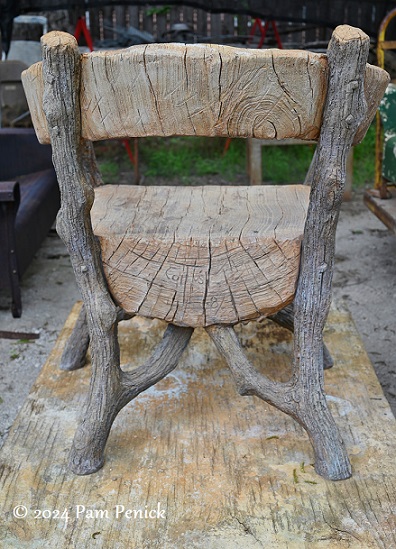
Chair with a Cortés signature
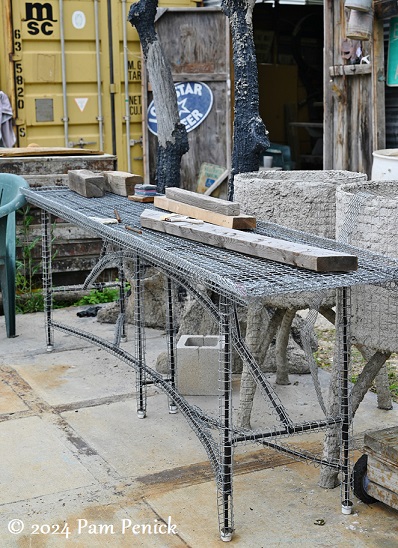
To make a work of trabajo rústico, Carlos bends rebar and welds or wires it together to create the skeleton of a piece, like this console table in-progress. He overlays that with wire mesh, building out the form.
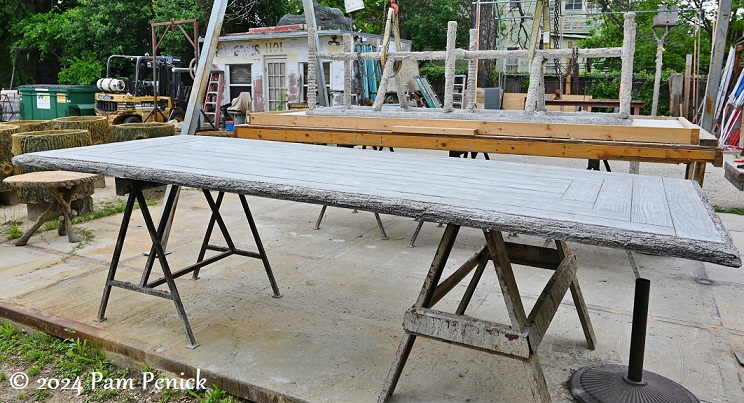
Next he applies several layers of concrete onto the metal form, mushing the concrete into the mesh. The finish coat is a smoother cement, which he etches, before it dries, with forks, trowels, wire screen, and other simple tools to create lifelike detailing: tree rings, bark, knotholes, scars, insect holes, sawn wood grain, or even nails, pegs, and shims that appear to connect pieces of wood — all faux.
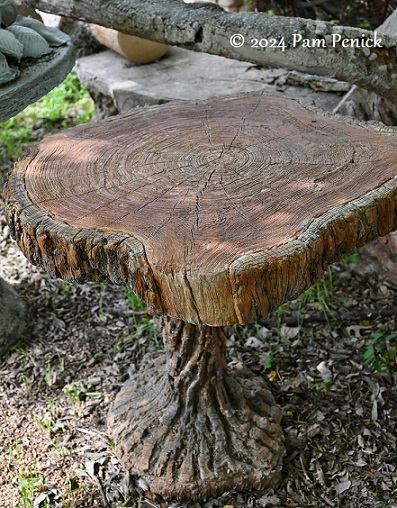
Lastly, color is applied for a finishing touch of verisimilitude.
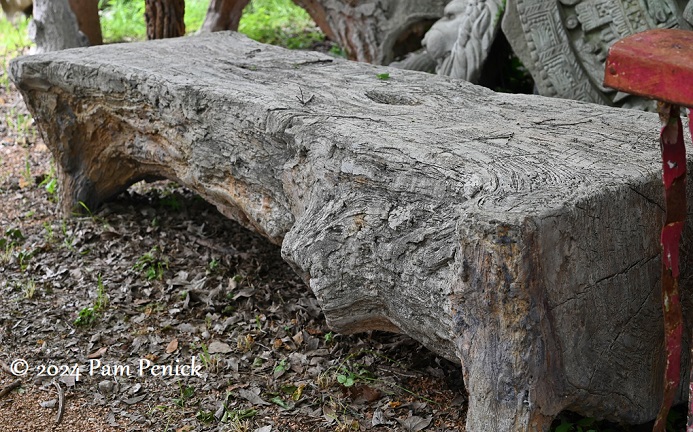
The more you look at a piece of trabajo rústico, the more you see. “Trees grow every which way,” says Carlos, “and they’re not perfect. But we can make a perfect imperfection.”
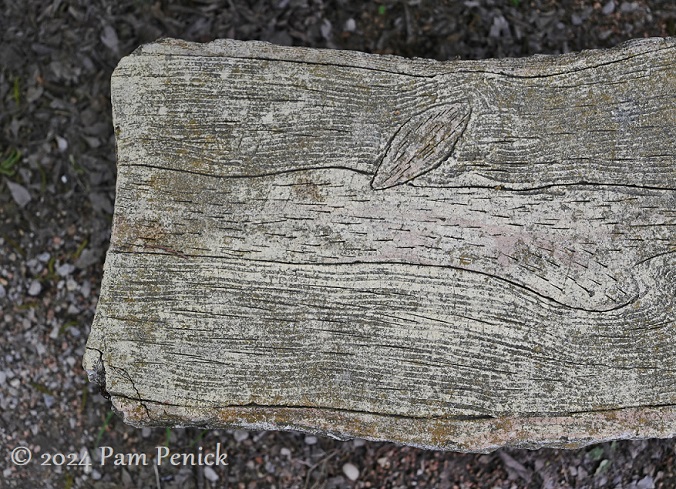
So convincing!
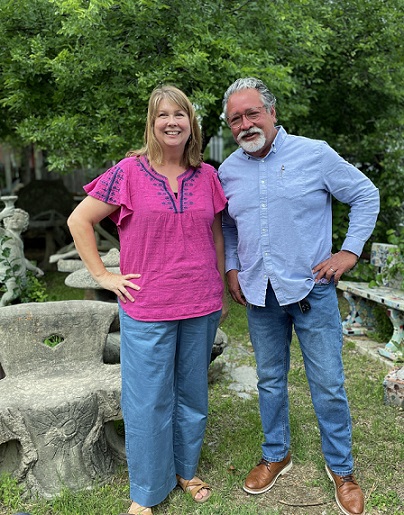
My sincere thanks to Carlos for making time for my visit and sharing his work with me. It was an honor to meet him and a great introduction to my day-long exploration of trabajo rústico throughout San Antonio.
Grotto on the River Walk
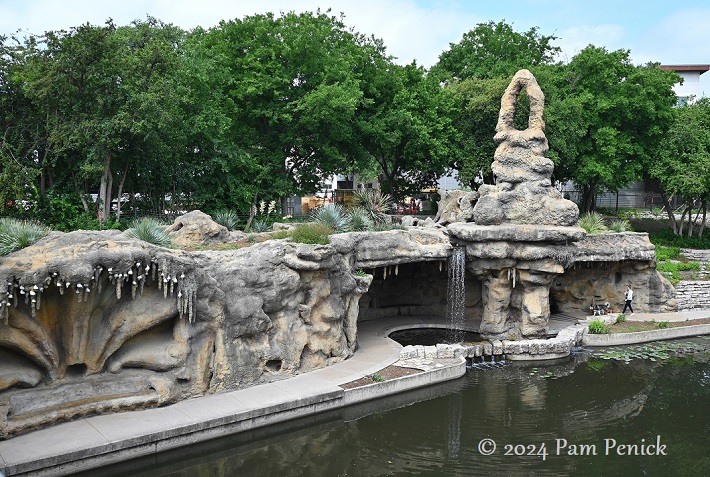
My next stop was the River Walk to see the Grotto, a monumental work by Carlos Cortés, constructed in 2009. Located in the Museum Reach of the River Walk, between Camden and Newell Streets, the Grotto includes a cave with stalactites, waterfalls, seashell fossils, and otherworldly faces. Carlos made it the way he makes trabajo rústico furniture — with rebar and concrete — but on a massive scale. It mimics stone, not wood. It’s a fantastical place to explore.
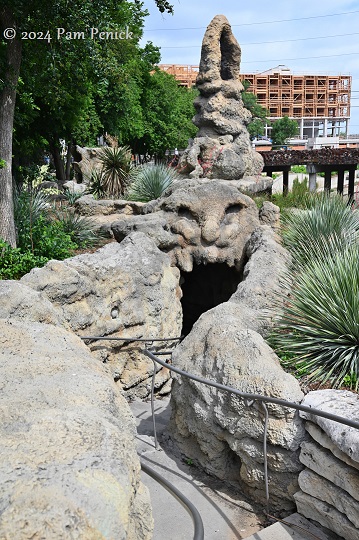
On one side you descend a curving stair through a jaguar’s mouth.
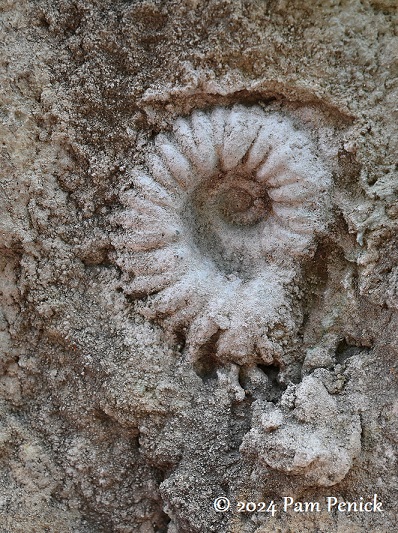
Fossils of ancient sea creatures appear in the walls, as if exposed over time.
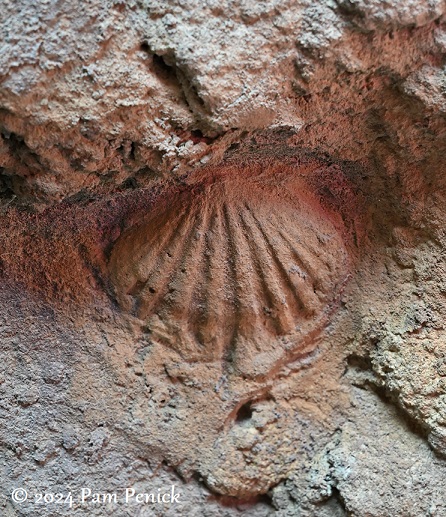
Another “fossilized” shell
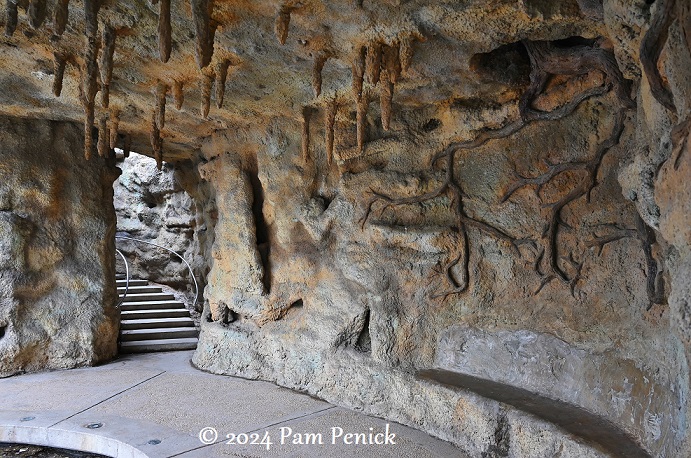
Inside the grotto, stalactites hang from the ceiling, and tree roots snake along the walls. A built-in bench offers a shady spot to rest.
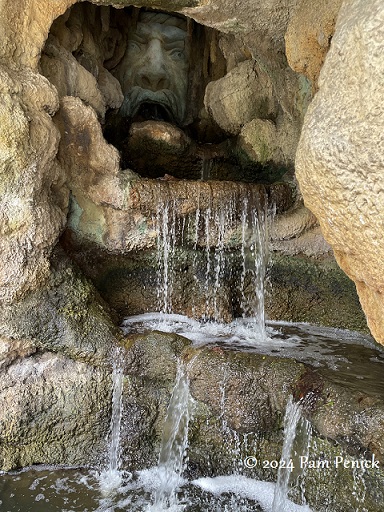
Looking up along a waterfall’s cascade, you see a stern, open-mouthed face high above — Father Nature, as Carlos calls him.
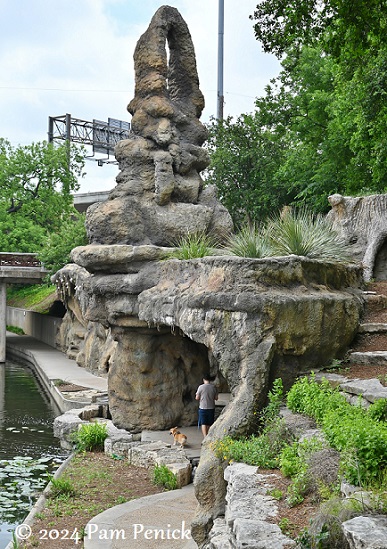
On the Grotto’s other side, sotols grow amid eroded “rock” formations and a faux tree stump.
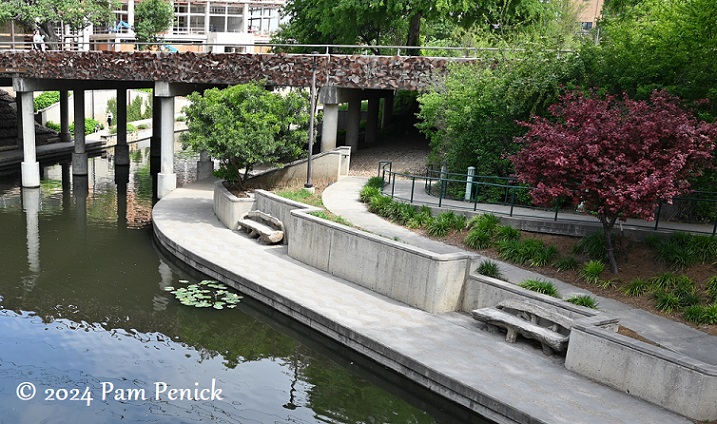
Across the canal, faux bois benches by Carlos offer places to view the Grotto.
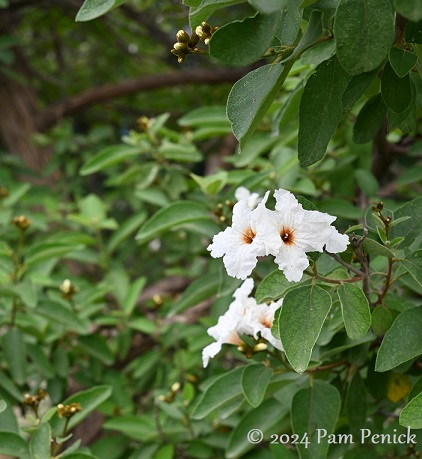
Mexican olive in bloom along the street
Palapa near the River Walk
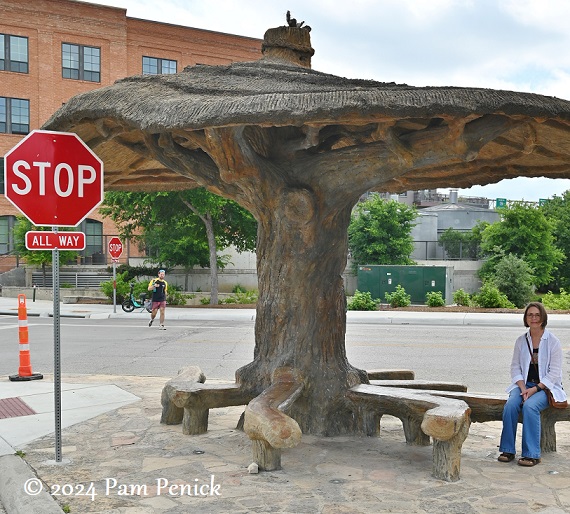
At street level across from the Grotto, a trabajo rústico palapa offers shaded benches. It too is a Carlos Cortés creation. Prickly pear (living, I think) sprouts from a planter built into the “thatched” roof.
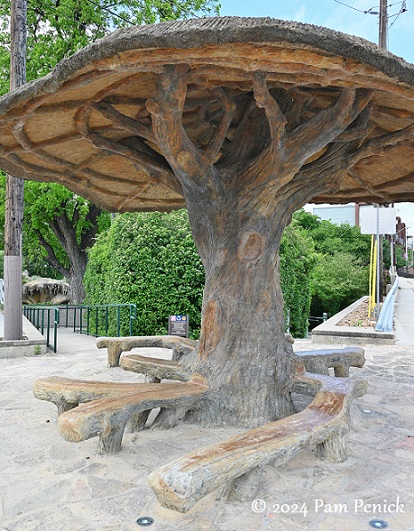
A large tree trunk holds up the roof. Rustic benches spiral from the base like stabilizing roots.
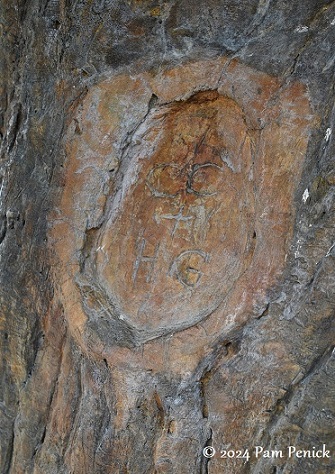
I spotted a lovebirds’ carving in a knothole: CC + HG. How sweet! It’s a tribute by Carlos to his wife, Hope Garza-Cortés, as Carlos’s son later confirmed.
Japanese Tea Garden
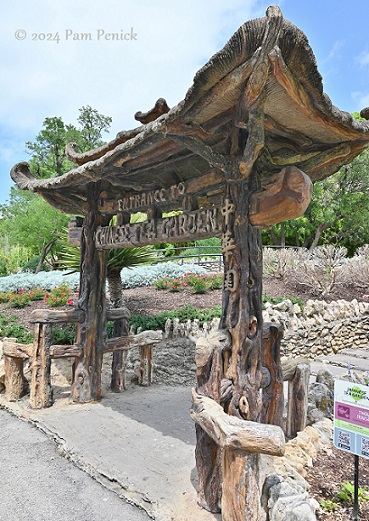
My next stop was the Japanese Tea Garden at Brackenridge Park to see its faux bois torii gate, constructed in 1942 by Dionicio Rodriguez (and Maximo Cortés, according to some sources). Lettering on the gate reads Chinese Tea Garden, not Japanese Tea Garden. That’s because of anti-Japanese sentiment after the 1941 attack on Pearl Harbor. As the United States went to war against Japan, the garden was renamed Chinese with the new gate. Forty-two years later, in 1984, the Japanese designation was officially restored. The misnamed torii gate remains as a historical artifact.
I’ll share more about the Japanese Tea Garden in an upcoming post.
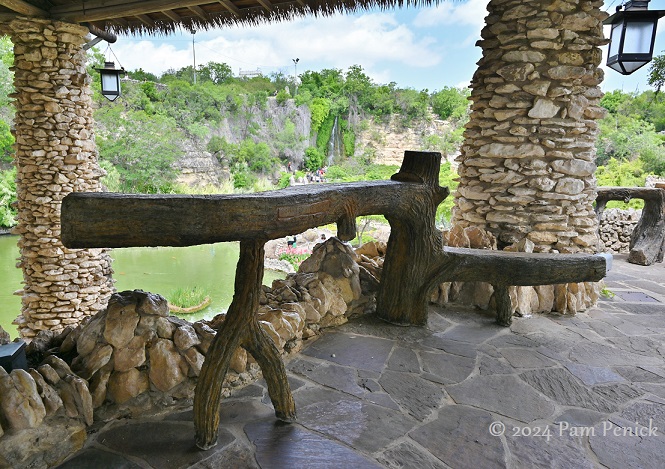
Inside the garden, I spotted more faux bois — benches and bar-height tables.
Footbridge at Brackenridge Park
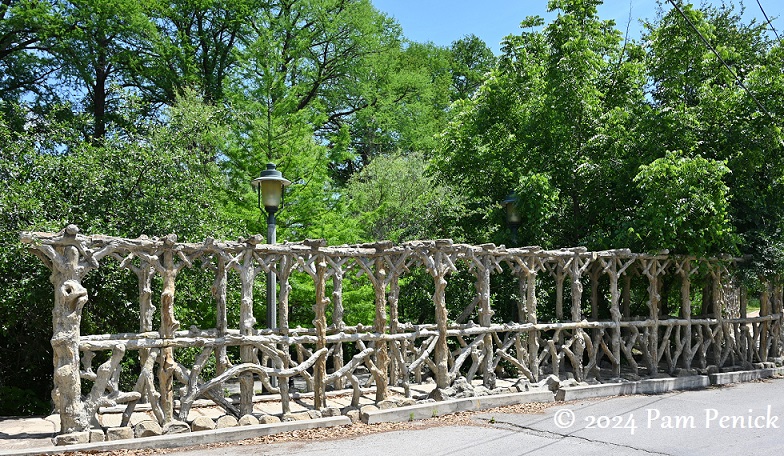
Also in Brackenridge Park stands a marvelous trabajo rústico footbridge, created by Dionicio Rodriguez in 1926. It’s located near a small parking lot off the E. Hildebrand Avenue entrance, close by the Stables.
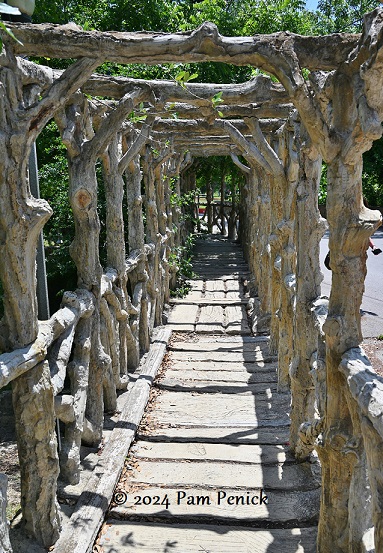
The bridge is constructed to look like rustic branches forming an arbor above sawn planks.
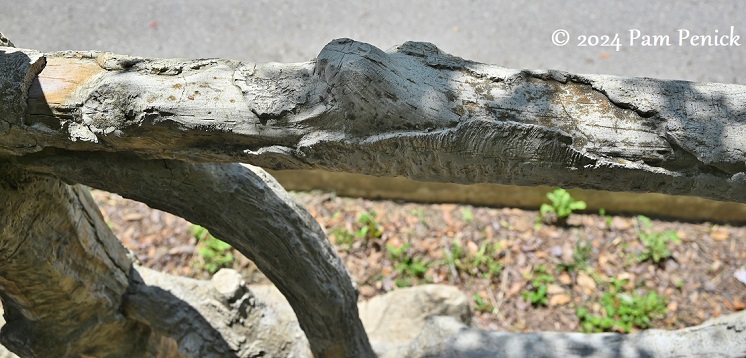
Walking through, I stopped to examine the lifelike branch detailing, including flaked-off bark, insect damage, and saw cuts.
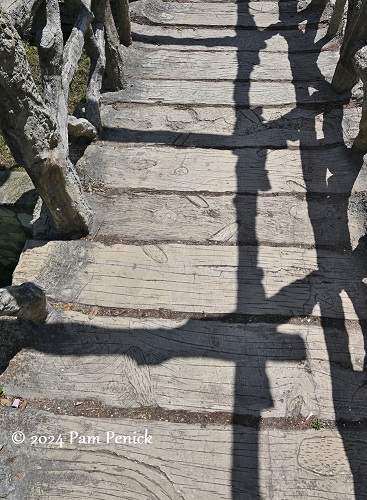
Doesn’t it look like real wood?
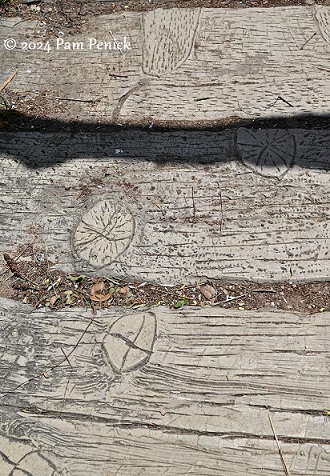
Plank flooring detail
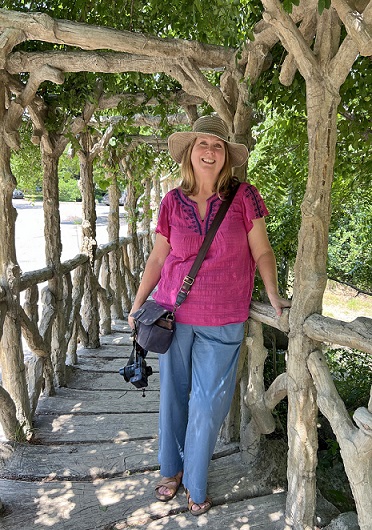
Here I am, enjoying the craftsmanship and arbor-like shade of the bridge.
Witte Museum arbor and treehouse
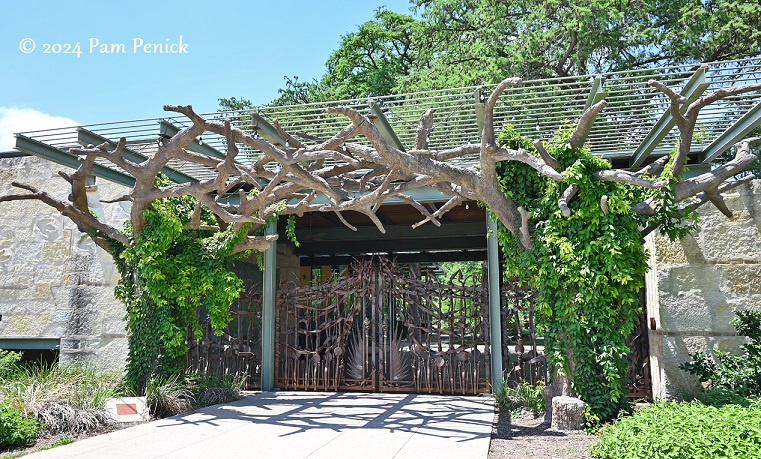
Next I headed to the Witte Museum in Brackenridge Park, where a pair of faux bois trees spans a gated entrance to the Mays Family Center.
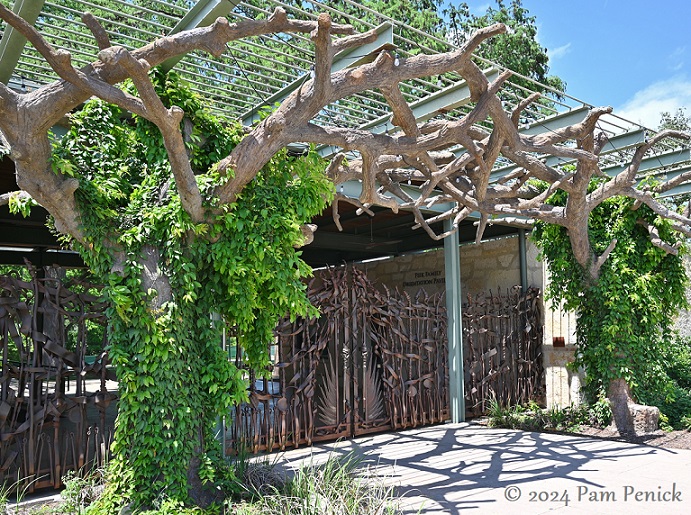
Carlos Cortés crafted the trees for the reopening of the Witte in 2017 after a major renovation.
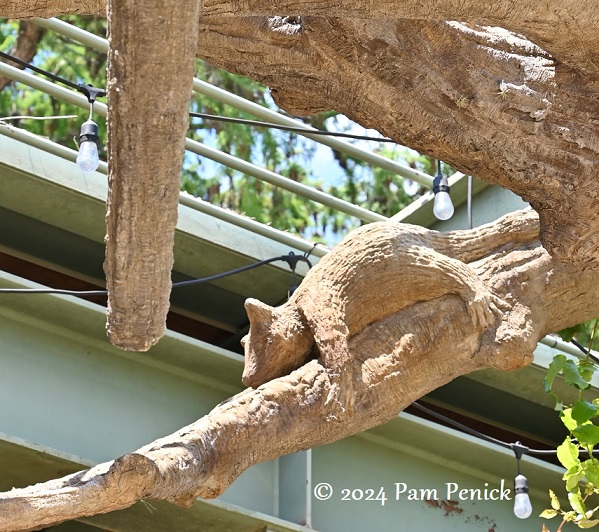
Looking up, you might spy a faux bois raccoon splooting on a branch.
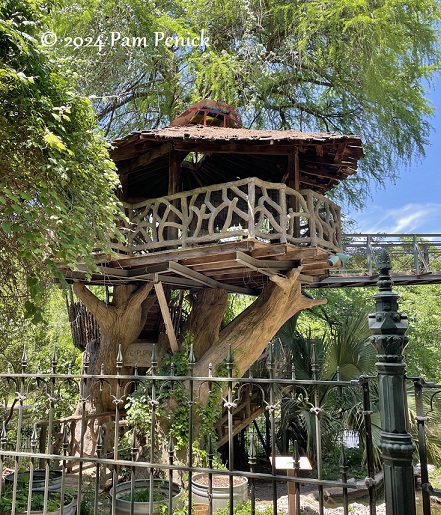
In the children’s adventure area of the Witte stands another Carlos Cortés construction: the HEB Treehouse — yes, faux bois also.
Palapa bus stop
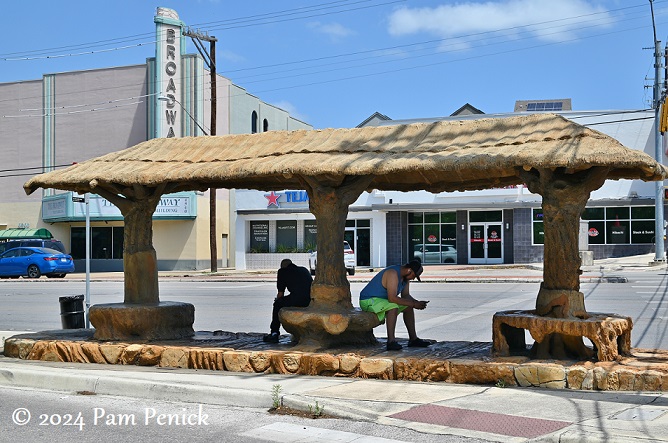
One of San Antonio’s quirkiest works of trabajo rústico is a palapa bus stop in the Alamo Heights neighborhood, at the corner of Broadway and Patterson Avenue. Dionicio Rodriguez built it in 1927 as a streetcar stop.
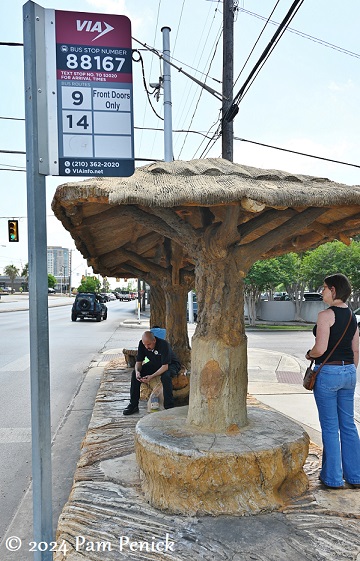
The whole thing — three tree trunks with circular benches, topped with a “thatched” roof — sits on a base of rough-hewn “wood.” Of course it’s all manmade of sculpted concrete.
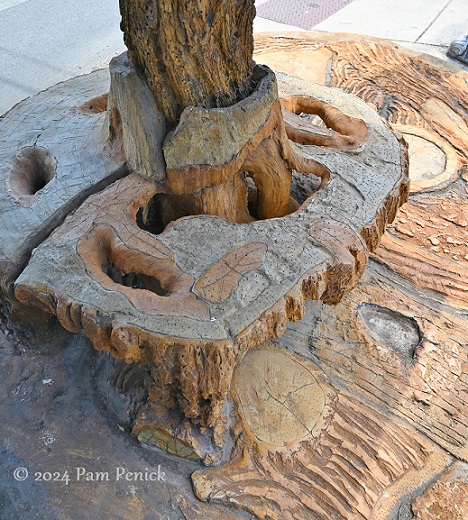
I can’t get over the detail, like the natural-looking holes in the faux wood benches.
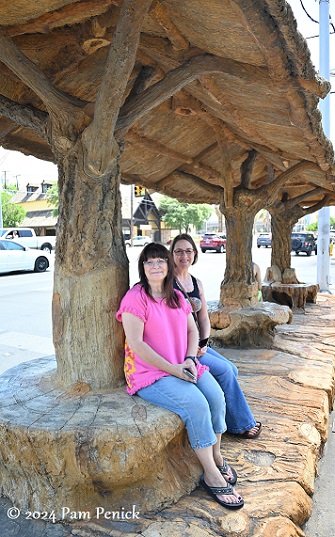
My companions on my faux bois expedition — Diana and Cat — enjoy a rest on the bus stop’s century-old benches.
Palapa and tables at Landa Library
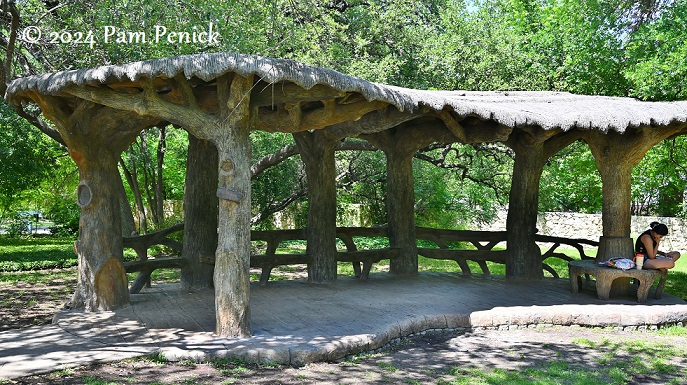
Next I headed to Landa Library in the Monte Vista Historic District to see a large faux bois palapa on the park-like grounds.
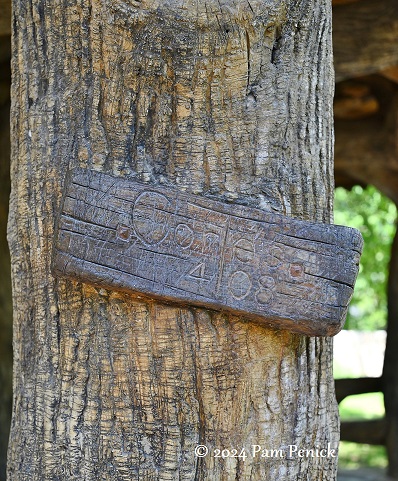
Carlos Cortés created it in 2008.
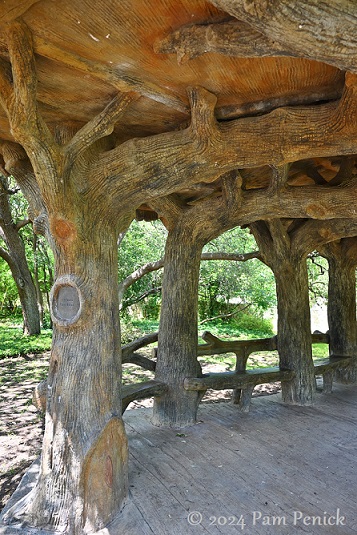
The sturdy limbs of seven trees support a thatched roof, with branch-backed benches connecting the trunks.
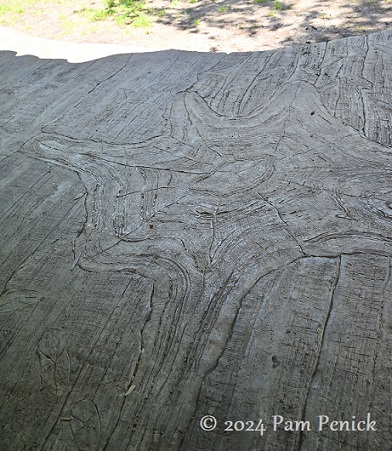
Floor detail — again, this is concrete, not real wood.
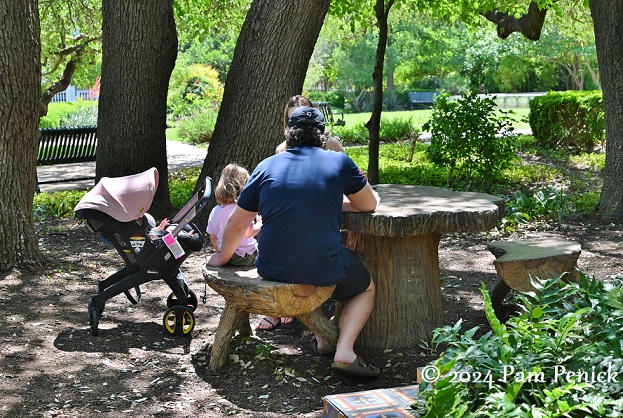
By the library, a few faux bois tables with benches, made by Rene Romero, were being enjoyed by visitors.
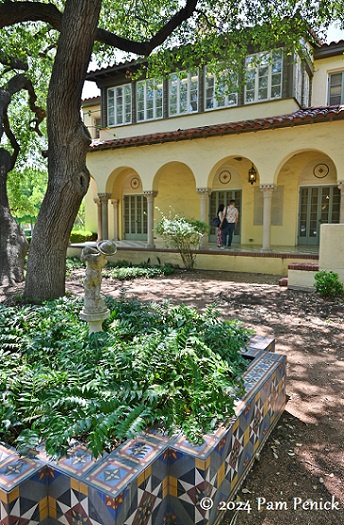
The library is the former Landa mansion, which I wish I’d gone inside. But I was on a faux bois mission!
Linda Peterson garden
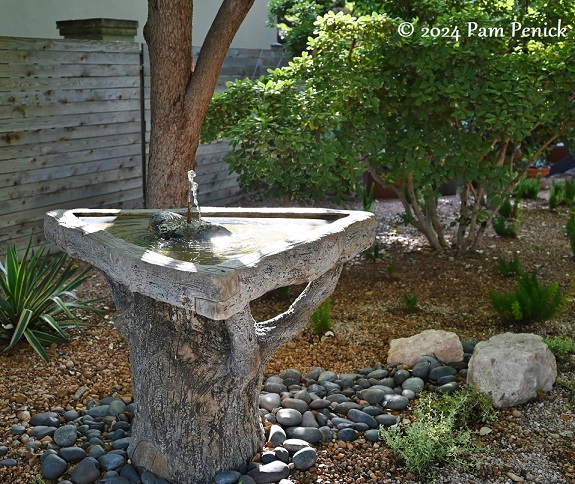
Our last stop was the garden of my friend Linda Peterson, where we enjoyed a leisurely visit and delicious homemade pineapple-coconut cake. She too has faux bois in her garden, connecting it to the city’s tradition. Here’s her faux bois birdbath with triangular basin, which she turned into a fountain.
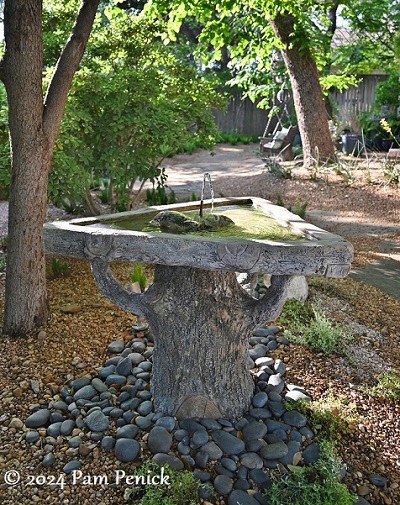
This piece belonged to her parents, and she inherited it.
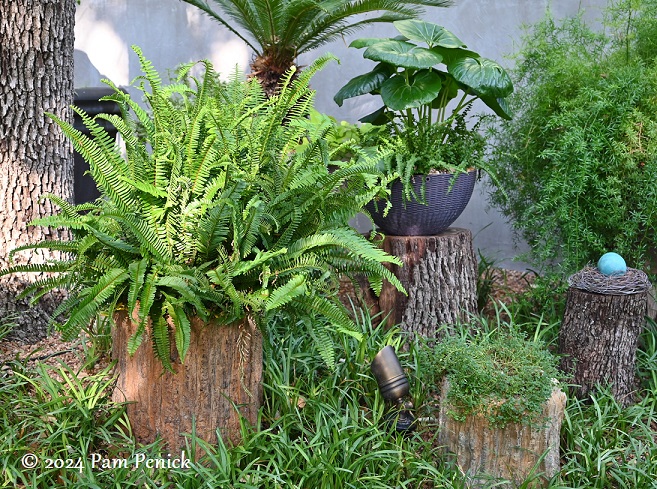
A family friend trying his hand at faux bois made two stump planters for her. Linda placed them in her stumpery, where they mingle convincingly with real tree stumps.
I’m fascinated by faux bois, aka trabajo rústico, and its ubiquitous presence throughout San Antonio. It’s a distinctive art form that celebrates the beauty of nature through mimicry. Look around and you’ll see it on street corners, in parks, outside public buildings, and in numerous private gardens all over the city. This year marks a century of trabajo rústico in San Antonio, and I hope the city will recognize the artists keeping this unique tradition alive.
If you’d like to read more about San Antonio’s faux bois artists and works, check out two books by Patsy Pittman Light: Capturing Nature: The Cement Sculpture of Dionicio Rodríguez and Artisans of Trabajo Rústico: The Legacy of Dionicio Rodríguez.
And click here to read Part 2 of my recent visits to San Antonio.
I welcome your comments. Please scroll to the end of this post to leave one. If you’re reading in an email, click here to visit Digging and find the comment box at the end of each post. And hey, did someone forward this email to you, and you want to subscribe? Click here to get Digging delivered directly to your inbox!
__________________________
Digging Deeper
May 4: Explore “brilliant backyards, perfect pools and pergolas, and outdoor rooms and gardens” on the ATX Outdoor Living Tour on 5/4, 10 am to 3 pm. Landscape architects, designers, and builders will be on hand to answer questions. Tickets are $33.85 for adults, $17.85 for kids age 10-17.
May 11: Tour four Austin gardens on 5/11, from 9 am to 3 pm, on the Inside Austin Gardens Tour. Each garden “is created and cared for by a Travis County Master Gardener and demonstrates realistic gardening practices that inform and inspire.” Tickets are $25, or free for children 12 and under.
May 18: On Austin Home’s Great Outdoors Tour, held 5/18 from 10 am to 3 pm, find “Pinterest-worthy pools and outdoor kitchens to thoughtful plantings and stylish urban density solutions.” Tickets are $30.
May 18: Pop up to Dallas for the 2024 DCMGA Garden Tour on 5/18 from 10 am to 5 pm. Tickets are $18 if purchased online prior to 6 pm on 5/17, or $22 after 6 pm on 5/17 or at the event. For a sneak peek, click here.
June 1-2: Take a self-guided, 2-day tour of ponds and gardens in and around Austin on the annual Austin Pond and Garden Tour, held 6/1 and 6/2, 9 am to 5 pm. Tickets are $20 to $25.
Come learn about gardening and design at Garden Spark! I organize in-person talks by inspiring designers, landscape architects, authors, and gardeners a few times a year in Austin. These are limited-attendance events that sell out quickly, so join the Garden Spark email list to be notified in advance; simply click this link and ask to be added. Season 8 kicks off in fall 2024. Stay tuned for more info!
All material © 2025 by Pam Penick for Digging. Unauthorized reproduction prohibited.


LOVE IT!!! well worth waiting for, thanks!!!
I’m glad you enjoyed it, and thank YOU for being a part of that lovely day exploring outdoors.
Great post, Pam! I have seen most those wonderful pieces and they are truly amazing. The ‘stone’ grotto is so similar to Gaudi’s work in Barcelona, that it must surely have been inspired by it. San Antonio is a beautiful city, especially the old parts close to downtown.
One little niggle — “FATHER NATURE”?! Mother doesn’t like that.
It is indeed a beautiful city with many interesting places to explore. I need to go back again soon. Regarding Father Nature, that’s Carlos’s point of view of his creation, not mine. 🙂 I’ve added that clarification.
Wow! I’ve always loved faux bois creations but I’ve never seen such a wide variety of uses of this wonderful form of art. Thanks for sharing your adventure, Pam.
San Antonio’s artists have really run with this art form!
I have always been fascinated by faux bois, and this vicarious visit to see this amazing artistry is a real treat! I found myself enlarging each photo to study the details. Mind blown! Thank you!!
I’m so glad you enjoyed the faux bois exploration, Cynthia!
Amazing!!
They really are, Kristin. Thanks for your comment.
Fascinating, incredible, and delightful!
Aren’t they? I had such fun looking at each piece.
Sometime you will have to make a trip to the city cemetery in Memphis TN, where there are dozens and dozens of works by Dionisio Rodriguez. The Crystal Shrine Grotto defies description, the “Aztec” plaza, and the various faux bois pieces, large and small, so worthy of your time!
I would love to see them, Jeanne. Thanks for the heads up about this place. I’m adding a link here to the cemetery for anyone who’d like to see pics.
WOW! This was a fabulous deep dive Pam, thank you. I kept thinking “that’s my favorite!”, no “that’s my favorite!” over and over. The carved “+” initials were such a nice touch (even thought I hate when people do that to real wood/plants).
I’m glad you enjoyed the post, Loree. I did a little more diving into faux bois yesterday during a family outing to San Antonio. Naturally my eyes were peeled for more faux bois, and I found it all over the place.
I absolutely love this art form. I have seen it and it makes my heart go pitty patter every time. I am so glad you brought this artist and his work to the fore.
Thanks! I’m so glad to have met Carlos and learned more about trabajo rustico in San Antonio.
We lived in San Antonio in 1972 and bought a 2′ diameter 3′ high bird bath from an ancient gentleman of hispanic heritage because we had never seen anything like it. Although we have lived in Central Texas ever since, I didn’t realize it was famous until about 50 years later. Trabajo Rustico! Thanks!
It sounds like you have a trabajo rustico treasure. Congrats on a good purchase!
Hey Pam, I’m in San Antonio quite often riding my bicycle and have seen many of these works. However, your post really gave me a new appreciation of the art form and I smile as I ride by them. Thanks!
Once you learn about it, you really start to notice this art form everywhere in San Antonio — and beyond.